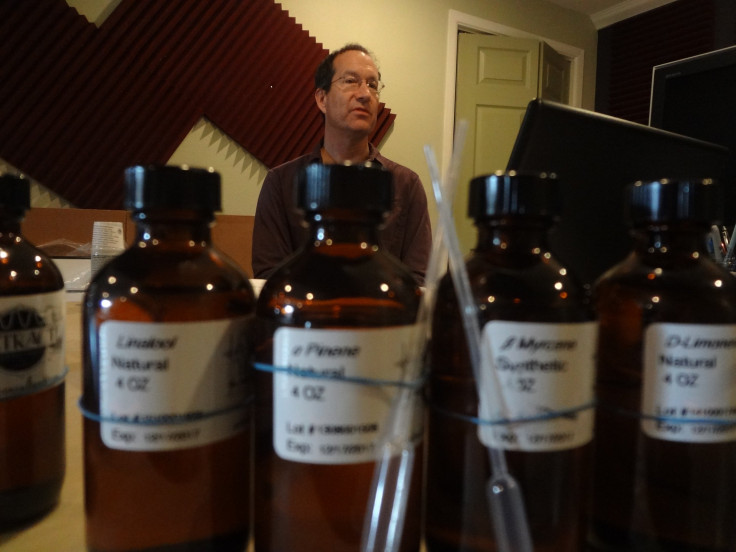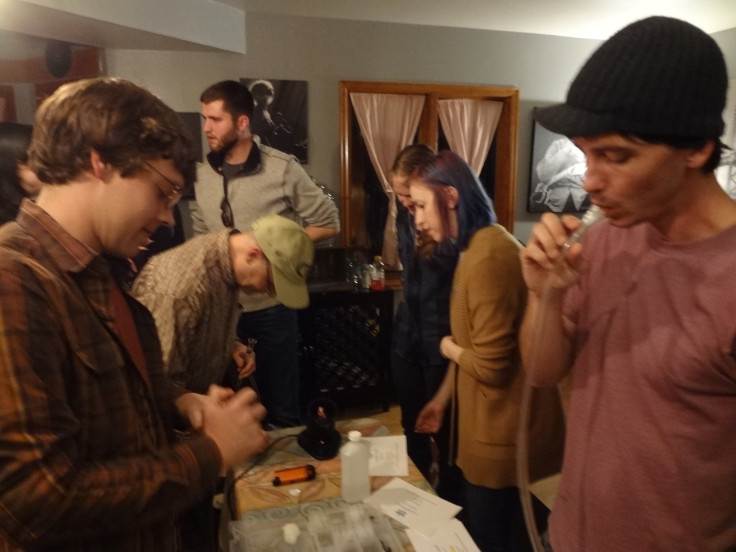Cannabis 2.0: Are Terpenes The Secret To Customizable Highs?

BOULDER, Colorado — Humming to himself, Charles Jones makes his way up a muddy hiking trail snaking through the Colorado foothills on an unseasonably warm winter day, his colleagues Dave Georgis and David Lohndorf following close behind. Part of the way up the trail, with the city of Boulder stretched below, Jones stops and smiles at the others, then at me. “Should we do a mood?” he asks.
Forty-five minutes earlier, the four of us had been sitting in the basement of Georgis’ Boulder bungalow, which doubles as the headquarters for Jones, Georgis and Lohndorf’s startup Chooze Corp. One by one, we had taken puffs from a tabletop vaporizer device, inhaling vapors from hemp pellets laced with equal amounts of pure THC, the psychoactive component of marijuana, and cannabidiol, or CBD, the part of the plant believed to be responsible for many of cannabis’ medical benefits. This was the first step in experiencing Chooze Corp.’s one and only product, LucidMood. When Georgis had handed the vaporizer’s glass mouthpiece to me, the vapor, free of all the usual ingredients that come with smoking or vaporizing marijuana buds, tasted smooth and a bit medicinal. It left me with a clear-headed high.
Now, in the middle of our hike, we are ready to move on to the second step of the LucidMood experience. It was time for the “moods” — hemp pellets that, when vaporized, are designed to customize a user’s psychoactive experience, leaving the user energized, or relaxed or focused, depending on what sort of experience is desired. “We’re designing the high to match the activity you want to enhance, whether that be making love or going skiing,” Jones had told me earlier.
Chooze is calling its tailor-made highs “Cannabis 2.0.” The product is based on terpenes, the organic compounds in marijuana and many other plants that are responsible for aromas. For years, marijuana producers have focused on maximizing THC, selectively breeding the plant to emphasize the psychoactive component over all others and developing cannabis concentrates free of other parts of the plant. But recently, many in the industry are starting to think marijuana’s psychoactive effects are shaped by its pungent terpenes, similarly to how aromatherapy works. Now marijuana websites are deconstructing the potential psychoactive properties of different terpenes: concentrate makers are championing pricey terpene-packed “live resin” and “terp juice” extractions, and ebbu, a Colorado startup co-founded by a videogame designer, has attracted millions in funding by promising to deliver customizable highs based on specific formulations of terpenes and other cannabis components.
But Chooze, in just 10 months and with a $100,000 investment, says it’s beating everyone to the punch. The company says it has developed consistent, made-to-order psychoactive experiences by lacing each of its different mood pellets with terpenes derived from non-cannabis sources. If that’s the case, when LucidMood products launch in the coming months, they could very well usher in a new era of cannabis consumption. But when so much about marijuana still remains unknown, could the secret to Cannabis 2.0 really be so simple?
On the hiking trail, Georgis pulls out a plastic baggie filled with mood pellets and fires up a portable vaporizer. “I think I could go with ‘Contentment,’” says Jones, and Georgis pops a pellet into the device. Once Jones has inhaled the resulting vapor, Georgis goes for a ‘Relaxation’ pellet and Lohndorf opts for ‘Body Buzz.’ Then they hand me the vaporizer, loaded with ‘Contentment.’
I take a puff and wait to see what happens.
Cracking the Terpene Code
Tall and slim, with thin metal-rimmed glasses, Jones resembles a professor. That impression dissipates when he starts talking, ruminating on shared psychotropic experiences and meta-cognitive boosts and reminiscing about the life-changing impact of his first acid trip (which happened to coincide with his first Grateful Dead concert). He calls himself an independent cognitive scientist, noting, “My ability to reflect on my own cognition is extraordinary.” Growing up in West Virginia, he thought he wanted to be a brain surgeon, but ended up studying computer science in college and exploring Eastern religions as well as various mind-altering substances. He worked in software development until a dot-com he launched failed in 2001, and then became an executive coach and launched the Institute for Adaptive Mastery, which trains people in how to increase their emotional intelligence.
Jones never tired of exploring cognition, however, including what his cognition was like on marijuana. When Colorado launched its legalized cannabis market in 2014, he became fascinated by the different effects of various marijuana strains, and he began researching the phenomenon. He stumbled upon terpenes, the 100 or so different aromatic compounds found in cannabis and other plants that function as natural pest control. The terpenes appeared to have therapeutic benefits and mood-altering effects — effects that seemed to be amplified when paired with THC. “Cannabis as it exists in North America almost always has high THC content, and yet consumers have always thought there are vast differences between one stain and another,” said Dr. Ethan Russo, medical director at the Los Angeles-based biotechnology firm Phytecs, who has long studied cannabis compounds. “It couldn’t be simply due to the amount of THC in it, so it had to be something else. On their own, some of the effects of terpenes are subtle. But there seems to be these boosting effects when combined with THC.”

It’s why, in a rapidly expanding cannabis market where brands are eager to stand out, entrepreneurs are turning their attention to these overlooked compounds. “The whole area with terpenes is really exciting,” said Steve DeAngelo, president of the ArcView Group, a major marijuana industry investment firm. “What is becoming more and more clear every day is the particular psychoactive properties of cannabis are not solely dependent on the cannabinoid profile. There is a synergistic effect between the cannabinoids and terpenes.” At an ArcView event in Denver last summer, DeAngelo ended his presentation with advice to investors in the audience: “I am just going to give you one word. And that word is terpenes.”
But so far, no one has been able to fully deliver on terpenes’ promise. While ebbu launched with major fanfare in 2014, so far the company has only released the sort of concentrates, vape pens (handheld vaporizers) and topical products already being produced by other cannabis companies. According to its website, its “ebbu Feelings” product line, which will use terpene and cannabinoid formulations to produce specific feelings such as “Chill, Bliss, Energy, Giggle, and Create,” won’t be available until 2017. Jon Cooper, ebbu’s CEO, couldn’t be reached for comment.
Jones, however, was determined to crack the terpene code. He recruited to his cause several like-minded colleagues: Georgis, a mechanical engineer with whom he’d bonded over a joint at a Furthur concert, and Lohndorf, a friend who first heard Jones’ plan for customizable highs while they were both pleasantly impaired at Frozen Dead Guy Days, an annual celebration in the nearby mountain town of Nederland.
But how would Chooze, their new company, deliver its tailor-made highs? First they envisioned a desktop machine that, paired with a smartphone app, would emit different terpene-dominated products, like a Keurig machine for cannabis (not to be confused with CannaCloud, a Keurig-like cannabis machine designed by former Keurig executives). Then they considered different colored pills that resembled marijuana-filled Tic Tacs. They ended up going simple: THC and terpene-infused hemp pellets that consumers insert into the vaporizer of their choice.
They had their first test run last April. With the help of an organic chemist they knew, they vaporized cannabis leaf pieces laced with THC and CBD, then repeated the process with leaves infused with what they thought was all the same terpene. Five minutes later, Georgis was lying on the carpet, watching contentedly while Jones and Lohndorf enthusiastically chatted back and forth. That’s when the chemist told them he’d secretly given them different terpenes.
In their minds, the conclusion was clear: “It worked,” said Georgis.
The Wikipedia Approach to Getting High
“Listen to this room,” said Jones. “This is not a pot party.”
He’s standing off to the side of one of Chooze’s now-regular “tasting parties,” this one being held in a colorful marijuana-friendly vacation rental in downtown Boulder called Castle B. An hour into the event, there’s a lightly boisterous buzz among the 20 or so in attendance; folks talk energetically over the Sam Cook record playing on a turntable, while others mosey about sipping water, the only drink available. No one is slumped on the couch, too stoned to function. Jones credits the atmosphere to the table of vaporizers Lohndorf has been manning all night, providing attendees with LucidMood base pellets, and then offering up different mood pellets like a bartender serving various mixed drinks.
“It’s really fun and very social,” said Christina, an older woman wearing stylish glasses and a plush crimson scarf. “I like this idea of not being stoned out of my gourd. I feel totally clear.”

Chooze has been running these sorts of social alpha-tests since last summer, inviting friends, colleagues and local marijuana industry insiders to events where everyone samples various terpenes and gives feedback on what they experience. (“I am really horny,” one woman who hadn’t smoked pot since college noted on a response form.)
“You could do lots of double-blind studies, or you could put the tools out in this enthusiastic community and let them run the tests for you,” said Jones. “The former is the encyclopedic approach, but we’re taking the Wikipedia approach. We are open-sourcing terpene-mood discovery.”
Thanks to that open-source approach, Jones says the team has locked down the effects of the four main terpenes that will be the basis of their first product line. They discovered that the terpene D-Limonene, which has a citrusy odor, seems to produce an energetic high, so that’s the main ingredient in the mood pellets Chooze will call “Momentum.” Beta-caryophyllene, which has a spicy aroma, appears to create blissful highs, so it’s the foundation of the company’s “Contentment” mood. Linalool, which apparently has soothing effects, is the key to Chooze’s “Relaxation” mood, while beta-myrcene, which they found to be both mentally relaxing and physically stimulating, will be called “Body Buzz.” The company also says people can combine moods to create unique highs, or do a second mood a little while after the first to shift effects midstream.
Chooze aims to launch its first four moods and base pellets this spring in a handful of Boulder-based marijuana retailers. The product will be priced to compete with a glass of wine -- $3 for a base, 75 cents for each mood – and will come in boxes that resemble the packaging for high-end teas. (“We are targeting the LOHAS market,” said Georgis, referring to the upscale “Lifestyles of Health and Sustainability” demographic that tends to shop at places like Whole Foods.) Eventually, Chooze plans to introduce additional moods based on other terpenes and terpene combinations, as well as expand to other states. Finally, the company’s open-source approach will extend to its website, where users will be able to post their favorite mood “recipes” for different activities, whether that be yoga or getting work done (Jones wrote the majority of Chooze’s business plan on a combination of “Relaxation” and “Momentum”).
Some outsiders say what Chooze is doing -- using other plants’ terpenes to modify marijuana effects -- makes perfect sense. “This has been going on for a very long time,” said Dr. Kymron Decesare, chief research officer at Steep Hill marijuana testing and analytics company. “The ability for other terpeniods to modulate cannabis was noted over 2,000 years ago in Chinese pharmacopoeias, which suggested adding plants to cannabis. Now, as we put terpenes back in, we can rebuild these different profiles in psychoactivity.”
But others are highly skeptical of Chooze’s claims. Marijuana’s effects seem to vary tremendously depending on the people and the situation, not to mention possibly on the user’s genetic makeup. And thanks to the federal prohibition on most marijuana research, the plant itself is still mostly a mystery; even the distinctions between sativa and indica, long thought to be the two main types of marijuana, have turned out to be largely arbitrary. So is anyone really ready to deliver predictable, consistent highs to all consumers? “It is way, way too premature to say we are going to deliver a tailor-made effect today,” said Jeff Raber, founder and president of the California-based marijuana testing lab Werc Shop. “To understand which components will deliver that and which people in the population will respond, we don’t know any of that yet. I believe you can get there. But it won’t be anytime soon.”
The Power of Suggestion
After we vaporize the different moods on the Boulder hiking trail, the effects seem to rapidly hit the Chooze team members.
“Oh, wow, I can totally feel it,” said Georgis, who’d tried “Relaxation.”
“Well, I definitely feel less committed to getting anything done than I did four minutes ago,” said Jones, who’d opted for “Contentment,” before launching into a rendition of a Lovin’ Spoonful song.
I, however, don’t feel any different despite the “Contentment” vapor I’d inhaled. I’m as equally high as I was before, trying my best to concentrate on where I’m going as we navigate the winding trail. After a while, I ask to try a different mood, and Georgis hands me the vaporizer filled with a “Momentum” pellet. The vapor tastes slightly lemony, but still, there’s no accompanying boost of energy.

The others, however, seem to be fully under the sway of their various moods. “I’m a little sloppy,” said Jones as we make our way back towards the trailhead. “I’m a little lackadaisical about where I plant my feet. I don’t think I would go hiking on this again. I kinda just want to sit on the couch.”
I’m disappointed that I don’t feel anything, and it’s not simply because I feel left out. With the marijuana industry becoming increasing slick and corporate, Jones and his partners are the sort of quirky, passionate individuals you want to root for to succeed. And at a time when personal vape pens and other products are threatening to do away with the "pass-the-joint" social side of marijuana consumption, everything about Chooze, from Jones’ discussions on psychotropic experiences to its lively tasting parties, is authentically, appealingly fun, and that has to count for something. But are the specific effects that Jones and his partners promise from their products really due to individual terpenes, or are they due to the fact that they bring a lot of people together, get them high and then tell them they’re consuming something called “Contentment”?
The Chooze team members say they’ve run blind taste tests on their mood pellets and have come up with consistent results. But have they tried switching the labels — calling a “Relaxation” pellet “Momentum,” for example — to see if users still feel the appropriate effects? That, say Jones and his colleagues, is something they have yet to try.
Still, they are confident they’ve developed Cannabis 2.0. “We know,” said Jones. “We have no doubt at all.”
At one point during the hike, Georgis points to a nearby rock formation. “I’ve always thought that looks like the face of an Indian chief,” he said.
Jones stops and looks. He doesn’t say whether he sees the face, but he smiles and nods thoughtfully. “The power of suggestion,” he said, before continuing on up the trail.
© Copyright IBTimes 2024. All rights reserved.






















